List of 18 Puranas names (with meaning & explanation) (basic information)
Namaste friends, how are you doing today? Welcome to #BhagavanBhakthi website / blog.
Bhagavan Lord Sri Krishna (Vishnu) (Rama) (Trivikrama) and Goddess Sri Rukmini Devi (Goddess Sri Lakshmi Devi) blessings to you and your family!
In this website / blog, you will always learn about #Hinduism #Sanskrit language.
Also subscribe to my YouTube channel from this link #BhagavanBhakthi to view videos about #Hinduism #Sanskrit language.
Just before moving towards to know about “List of 18 Puranas names (with meaning & explanation) (basic information)“, let us know a brief, basic and very important information.
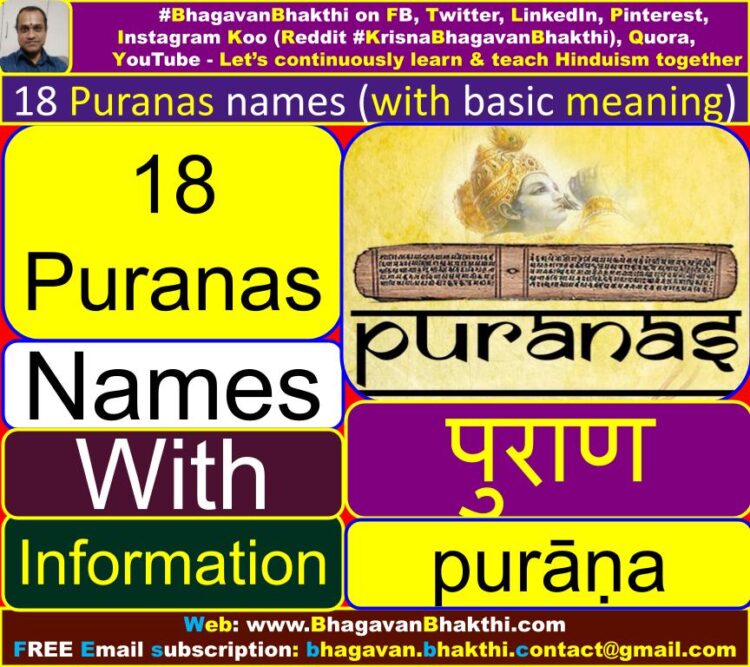
Who wrote 18 puranas : Lord (Sage) Sri Vedavyasa wrote (composed) all the eighteen (18) Puranas. He is the one who composed the great Mahabharata and he is an avatar of Lord Sri Vishnu himself. There is no difference between Lord (Sage) Sri Vedavyasa and Lord Sri Vishnu.
In Sanskrit Purana is written as पुराण (purāṇa). Purana means “ancient stories of Indian history“. Puranas have vast amount of the history which covers wide range of topics, particularly about real legends and other traditional lore of India (Bharata Varsha / Bharat Varsh).
Rishi Lomaharshana (Sutaji / Sutacharya) gave to other Rishis / sages a list of the eighteen Puranas names.
In the beginning, there was only one Purana. Lord (Sage) Sri Vedavyasa Ji (he is an avatar of Bhagavan Sri Maha Vishnu) divided this original Purana (Mahapurana) into eighteen Puranas.
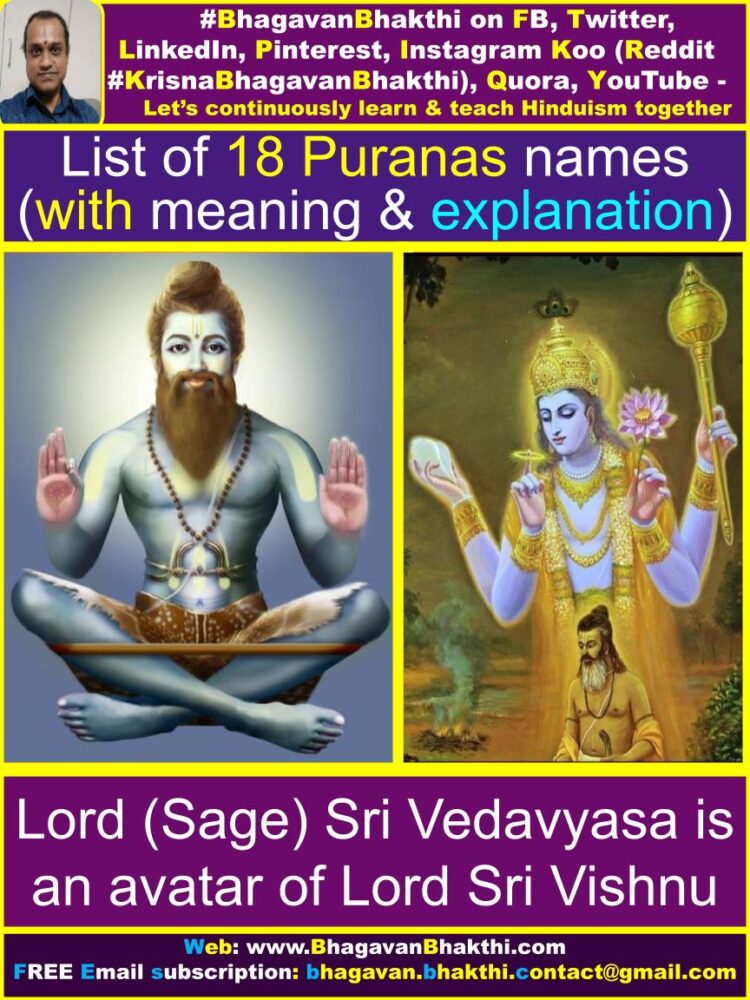
This was done as the people of Kali Yuga will be less knowledgeable and will not be able to understand the greatness of our itihasa / history which was given in a single Mahapurana. Thus the single Mahapurana was divided into 18 Puranas (अष्टदश पुराण).
The 18 Puranas have four lakh shlokas all together. First let us know the names of all 18 Puranas, later let us know the basic information about all those Puranas.
List of 18 Puranas names is as given below:
Brahma Purana, Padma Purana, Vishnu Purana, Vayu Purana, Bhagavata Purana, Narada Purana, Markandeya Purana, Agni Purana, Bhavishya Purana,
Brahmavaivarta Purana, Linga Purana, Varaha Purana, Skanda Purana, Vamana Purana, Kurma Purana, Matsya Purana, Garuda Purana, Brahmanda Purana
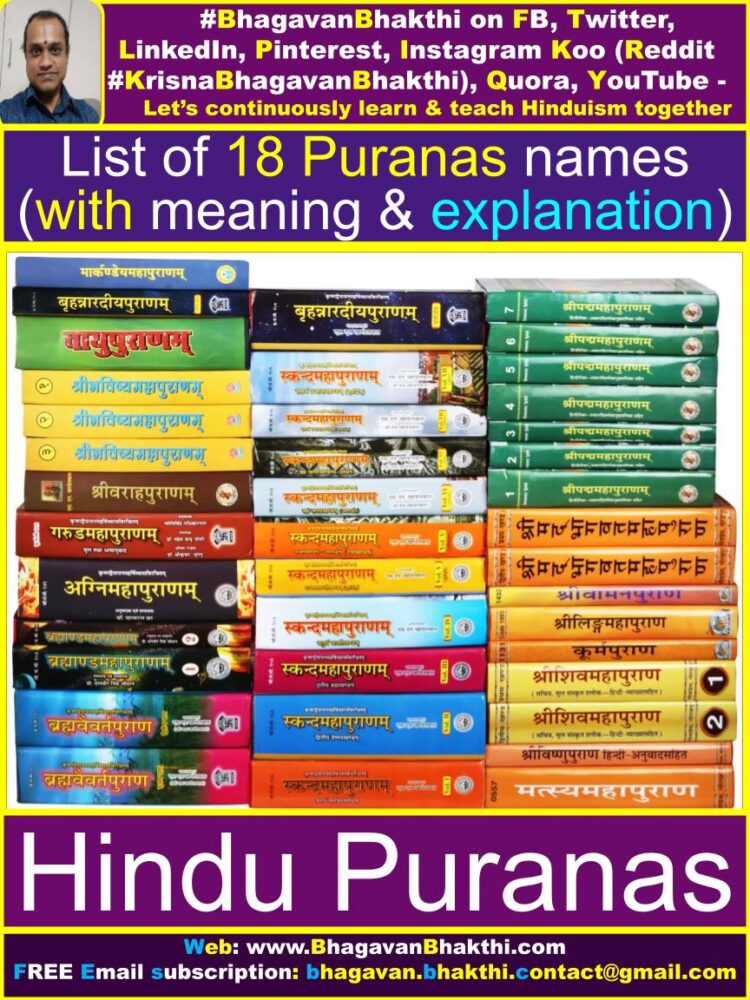
Now, let us know the basic information of all the above said Puranas.
Basic information of all 18 Puranas are as given below:
1. Brahma Purana : In Sanskrit Brahma Purana is written as ब्रह्म पुराण (brahma purāṇa). This was originally recited by Lord Brahma to the Rishi (Sage) Marichi and has thirteen thousand shlokas.
This text should be donated on a full moon night (Purnima) in the month of Vaishakha. Such a donation brings undying punya. Brahma Purana is listed as the first Maha Purana (Great or Major Purana) in all the anthologies, and thus this Purana also known as आदि पुराण (Adi Purana) (ādi purāṇa).
Brahma Purana is also known as सौर पुराण (Saura Purana) (saura purāṇa), because it contains many related chapters of Lord Sri Surya Deva (Sun God). This Purana is actually just a compilation of geographical Mahatmya (Greatness) and sections on diverse topics of Indian ancient history.

2. Padma Purana : In Sanskrit Padma Purana is written as पद्म पुराण (padma purāṇa). This has fifty-five thousand shlokas and should be donated in the month of Jyeshtha.
Padma Purana is named after the Padma (lotus flower) on which Lord Sri Brahma Deva (Creator god) appeared from the nabhi (navel) of Lord Sri Vishnu. This Purana includes large sections of stories devoted to Lord Sri Vishnu, as also a significant sections on others like Lord Sri Brahma Deva, Lord Shiva and Goddess Shakti.
Padma Purana says that, one who thoroughly understand the different descriptions of the opulences and expansions of Lord Sri Krishna and his energy.
Then one can indeed understand without any doubt the position of Lord Sri Krishna and can fix his (reader) mind in the worship of Lord Sri Krishna without any deviation.
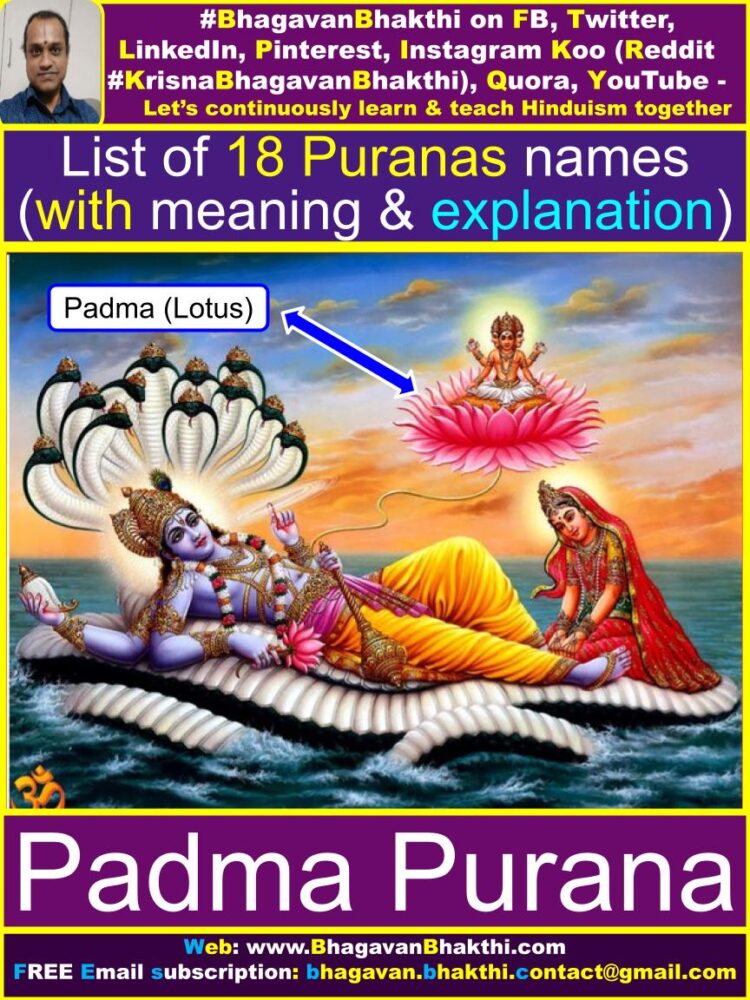
3. Vishnu Purana : In Sanskrit Vishnu Purana is written as विष्णु पुराण (viṣṇu purāṇa). This was first recited by the Rishi (Sage) Parashara and has twenty-three thousand shlokas. It is auspicious to donate this text in the month of Ashada.
Vishnu Purana contains the discussion between Rishi (Sage) Maitreya and his Guru Rishi (Sage) Parashara, with the Rishi (Sage) Maitreya asking like this:
“What is the nature of our universe and everything it contains?”
The Vishnu Purana talks about the cosmology, dealing with the creation, maintenance and destruction of the whole universe. The importance of the worship of Lord Sri Vishnu is explained in the 22 chapters of this Purana as the path for Moksha (liberation)
Also, this Purana contains the information about the profuse use of the synonymous names of Lord Sri Vishnu like हृषीकेश (Hrishikesha) (hr̥ṣīkēśa), माधव (Madhava) (mādhava), अच्युत (Achyuta) (acyuta), हरि (Hari) (hari), etc.
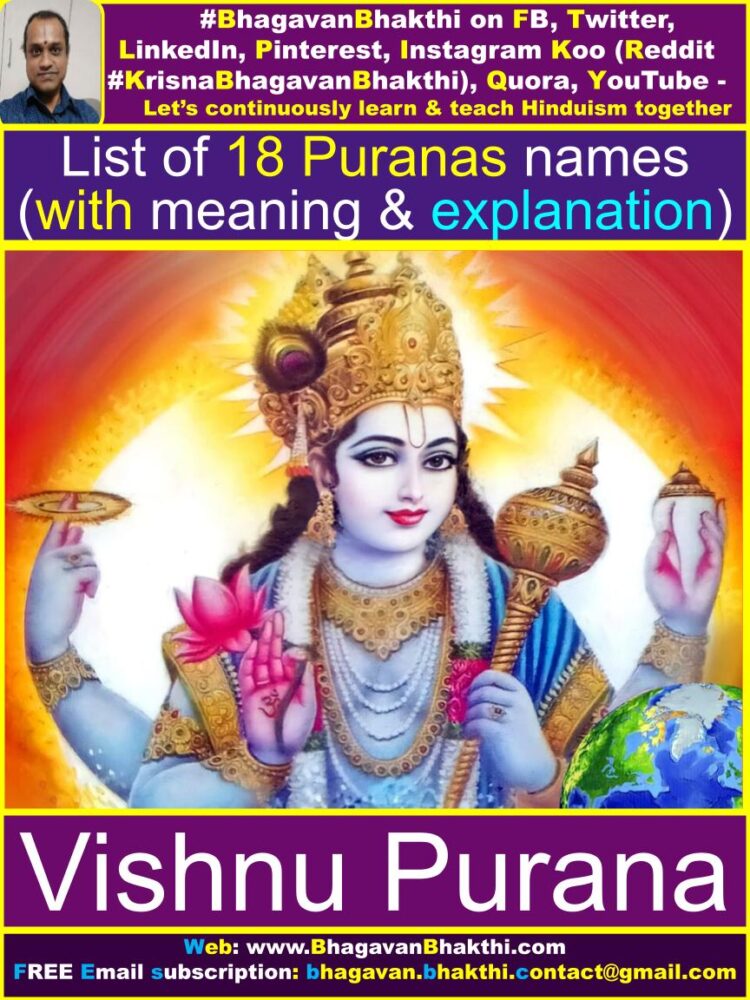
4. Vayu Purana : In Sanskrit Vayu Purana is written as वायु पुराण (vāyu purāṇa). This has twenty-four thousand shlokas and was first recited by the Lord Sri Vayu Deva (Wind God). It should be donated in the Hindu month Shravana.
The Vayu Purana narrates the theories about the cosmology, genealogy of Devatas (Demigods) and the Great Kings of both Solar Dynasty and Lunar Dynasty.
This Purana also mentions information about the mythology, geography, Manvantaras, the Solar System and the movements of the celestial bodies. Similarly, Vayu Purana talks about the duties of the Varna (caste or class) and duties of a person during various ashramas.
In addition to this, Vayu Purana discusses about the tapas (penances) for sannyasi (Hindu Monks), Dharma, Sanskaras (Rites of passage), and also about the theory of Naraka (Hell) in after-life.
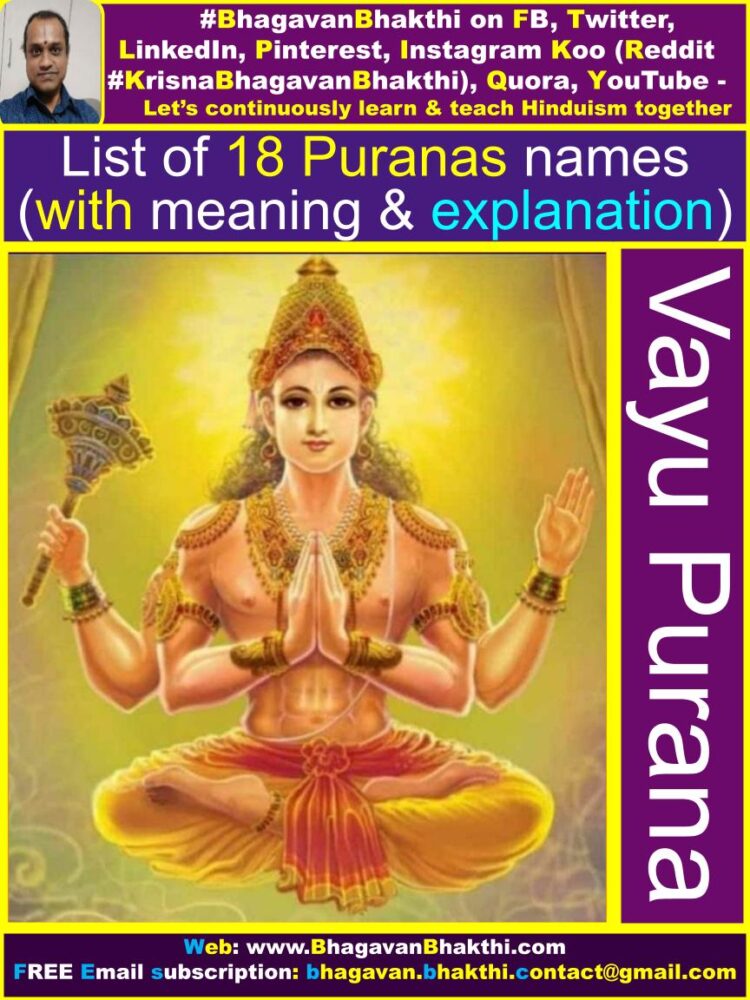
5. Bhagavata Purana : Bhagavata Purana in Sanskrit is written as भागवत पुराण (bhāgavata purāṇa). This has eighteen thousand shlokas and should be donated in the Hindu month of Bhadra, on the night of the Purnima (Full Moon).
The divine Bhagavata Purana is a devoted text for all the Vaishnavas, that is, who follow Lord Sri Vishnu. The Purana shows that Bhakti (devotion) ultimately leads to self-knowledge, Moksha (Liberation) and bliss.
The divine and auspicious Bhagavata Purana also talks about a broad range of information including astronomy, geography, dance, cosmology, genealogy, culture, legend, music, yoga, etc.
This Purana narrates the details about the inner nature and outer form of Lord Sri Krishna is identical to the Vedas and that this is what rescues the whole world from the forces of evil.
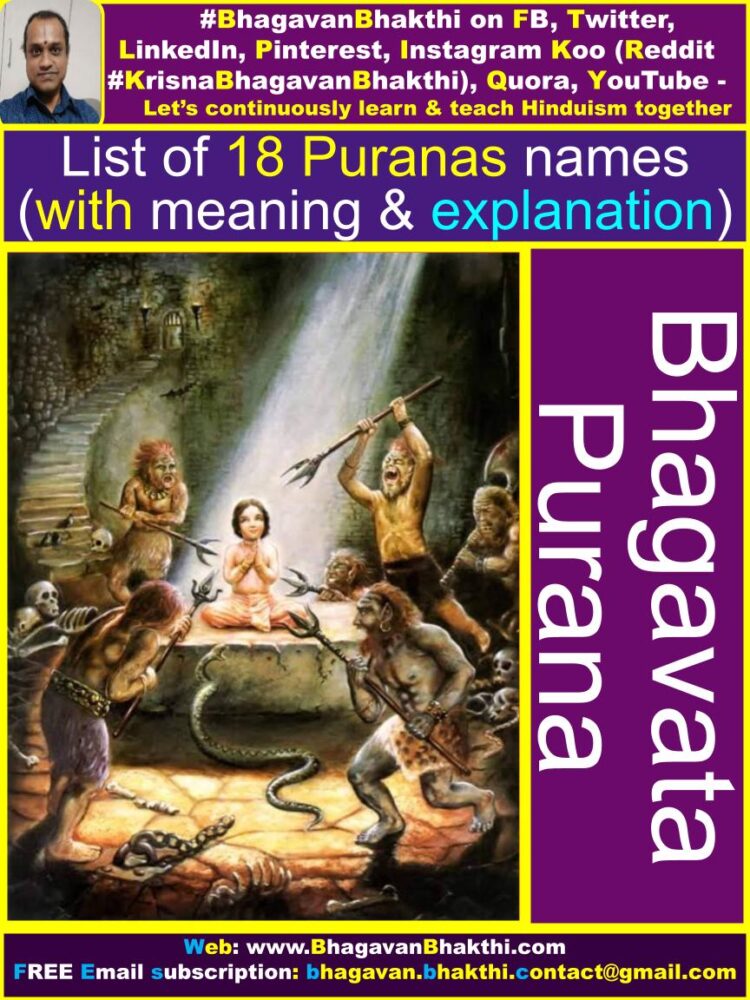
6. Narada Purana : In Sanskrit Narada Purana is written as नारद पुराण (nārada purāṇa). It is also called as Naradiya Purana (नारदीय पुराण) (nāradīya purāṇa).
This was first recited by the Devarishi (Sage) Narada and has twenty-five thousand shokas. It should be donated on the night of the new moon (amavasya) in the month of Ashvina.
The Narada Purana is dedicates the eighteen chapters on other Puranas and also one entire chapter explains about the each major Puranas.
This Purana also adds information about about the Lord Buddha avatar. The Narada Purana mainly gives importance on the Bhakti (devotion) of Lord Sri Vishnu. Narada Purana explains about the festivals and rituals in Vaishnavism.
Also, numerous chapters of this Purana eulogizes the river Ganges, pilgrimage places and travel centers like Prayag (Prayagraj) and Varanasi (Banaras).
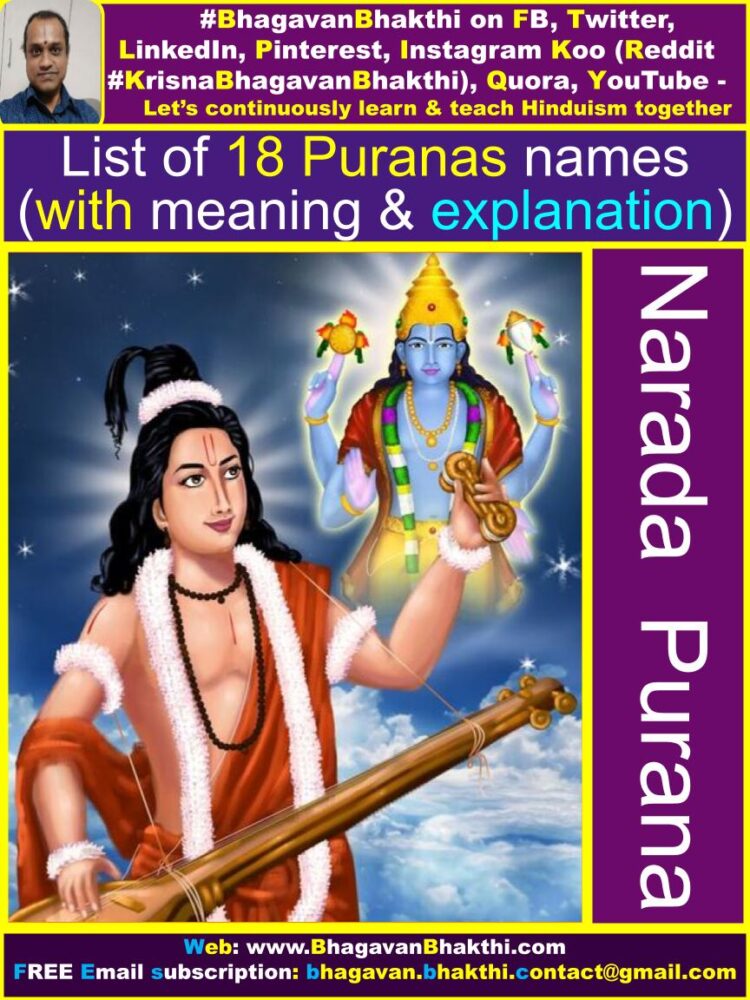
7. Markandeya Purana : In Sanskrit Markandeya Purana is written as मार्कण्डेय पुराण (mārkaṇḍēya purāṇa). This has nine thousand shlokas. A person desirous of obtaining punya should donate this text in month of Margashirsa.
In the Markandeya Purana Rishi (Sage) Jaimini asks Maharishi (Sage) Markandeya answers about few of questions regarding the Mahabharata.
Maharishi (Sage) Markandeya narrates that he needs to go and perform some Vedic rituals, and instructs Rishi (Sage) Jaimini to meet up with four wise birds who live in the Vindhya Mountain rage.
Rishi (Sage) Jaimini meets those birds and those birds answer his questions. This conversation will be about of Samsara (Sansar), Shraddha rituals, Dharma, Karma, etc. verses from Mahabharata and the Gautama Dharmasutras.
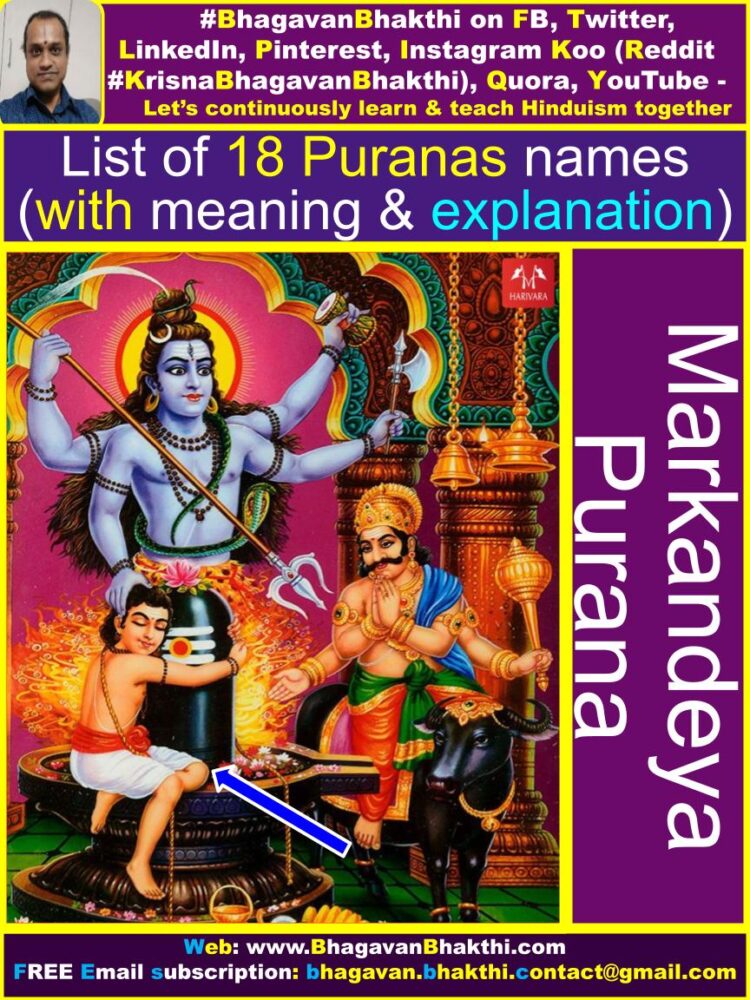
8. Agni Purana : This Sanskrit Agni Purana is written as अग्नि पुराण (agni purāṇa). This was first recited by the fire-god Lord Sri Agni Deva to the Maharishi (Sage) Vasishtha. Later Maharishi (Sage) Vasishtha recited it to Lord (Sage) Sri Vedayvyasa Ji.
It has sixteen thousand shlokas and should be donated in the month of Margashirsha. Both Matsya Purana and Skanda Purana describes that this Agni Purana explains about Ishana-Kalpa as described by Lord Sri Agni Deva.
Agni Purana narrates about grammar, lexicography, metrics, poetics, Tantra, Book summary, Regional geography, Medicine, etc.
Similarly, Agni Purana adds information about Buddhist incantations, Politics, Agriculture, planning, Martial arts, weapons, Cows, Hindu temple, monastery, Yoga, Moksha, etc.
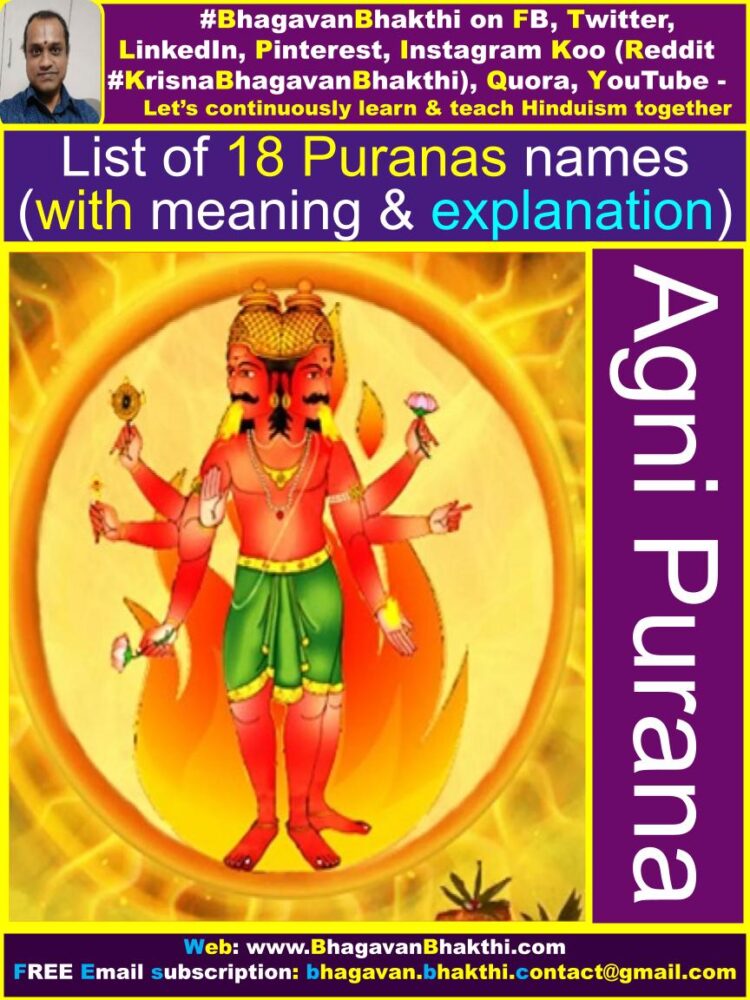
9. Bhavishya Purana : In Sanskrit Bhavishya Purana is written as भविष्य पुराण (bhaviṣya purāṇa). Lord Sri Brahma Deva himself was the first reciter of this Purana and it has fourteen thousand and five hundred shlokas.
It is primarily concerned with what is due to happen in the future. The text should be donated on the occasion of Purnima (full moon day), in the month of Pousha. Bhavishya Purana covers subjects like as ceremonies, rites of passage, feasts, etc.
This great Purana also adds information about the rights and duties of a women and also conversation about the nature of people and how to recognize good and bad qualities, a caste-related discussion, etc.
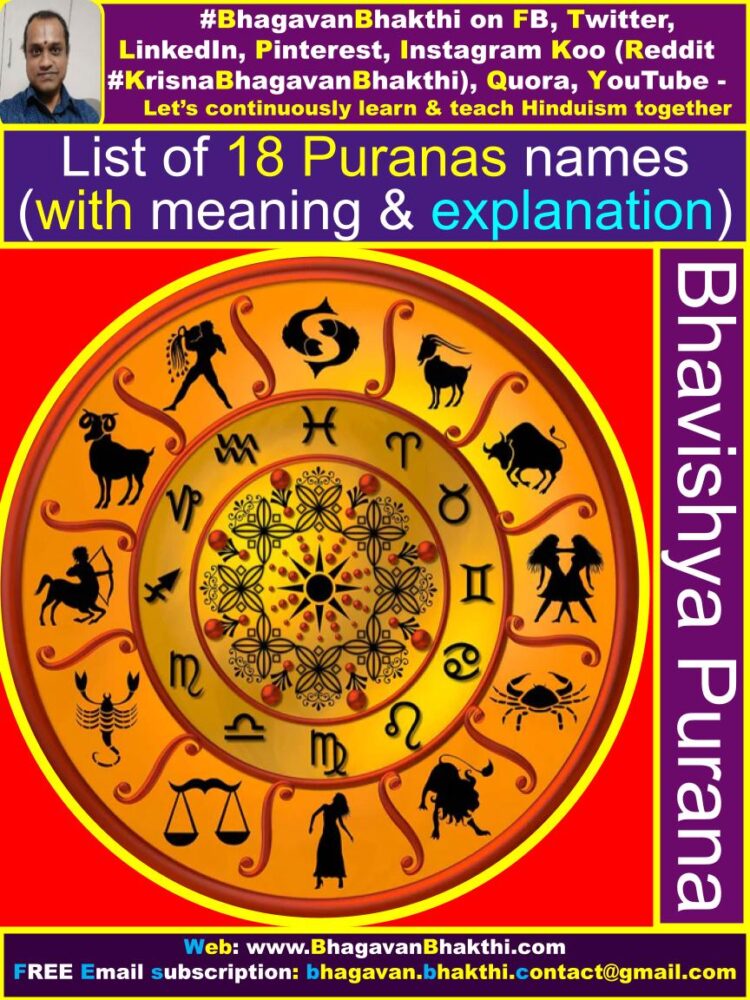
10. Brahmavaivarta Purana : In Sanskrit Brahmavaivarta Purana (Brahma Vaivarta Purana) is written as ब्रह्मवैवर्त पुराण (brahmavaivarta purāṇa). This was first recited by Savarni Manu to the Devarishi (Sage) Narada.
It has eighteen thousand shlokas and should be donated on purnima in the month of Magha. The Purana’s name ‘Brahmavaivarta‘ means “metamorphosis of Brahman“, that is, metamorphosis of Lord Sri Vishnu / Krishna.
This Brahmavaivarta Purana gives information about the creation by Lord Sri Krishna (Vishnu), who creates the universe and who is also present in the universe.
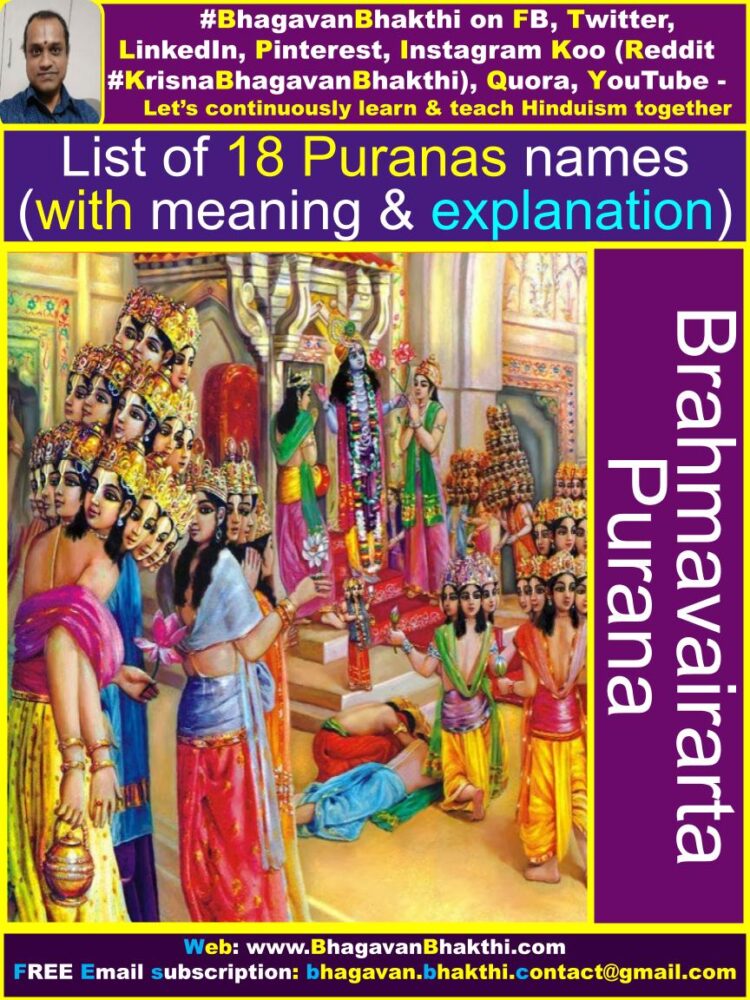
11. Linga Purana : In Sanskrit Ling Purana is written as (लिङ्ग or लिंग पुराण) (liṅga purāṇa). Lord Sri Brahma Deva recited this first and it has eleven thousand shlokas. Punya (good deeds) is acquired if this text is donated in the month of Phalguna.
The Linga Purana gives information about season, geography, cosmology, festivals, a tour guide for pilgrimage (Tirtha), etc.
Also this Purana adds the details about the stotras, handbook for the design and consecration of a Linga and Nandi. Similarly Linga Purana explains about the importance of these icons, a description of Yoga with claims of its various benefits.
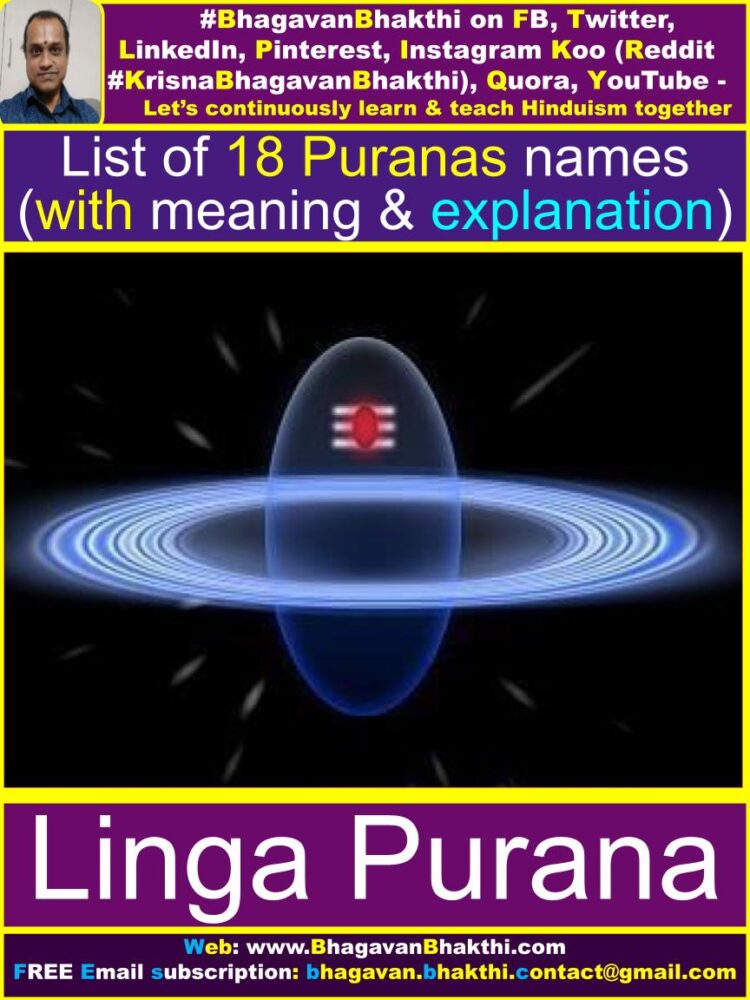
12. Varaha Purana : This Sanskrit Varaha Purana is written as वराह पुराण (varāha purāṇa). The Supreme Lord Sri Varaha (Vishnu) first recited this to the Goddess Sri Bhudevi (Mother Earth). It has twenty-four thousand shlokas and is to be donated in the month of Chaitra.
Varaha Purana includes information about the Goddesses and Lord Shiva and also has the discussion of Karma and Dharma called Dharmasamhita. This texts explains about the greatness of the temples and sites in Mathura and Nepal.
Varaha Puranas has the shlokas about the dialogue between the King Janamejaya and the Rishi (Sage) Vaishampayana. This part about the King Janamejaya and Rishi (Sage) Vishmpayana is also known as the Dharma Samhita.
Similarly, in Varaha Purana we can find the information about Rishi Sutaji (Sutacharya) narrating the conversation between Lord Sri Brahma Deva and Sanatkumara.
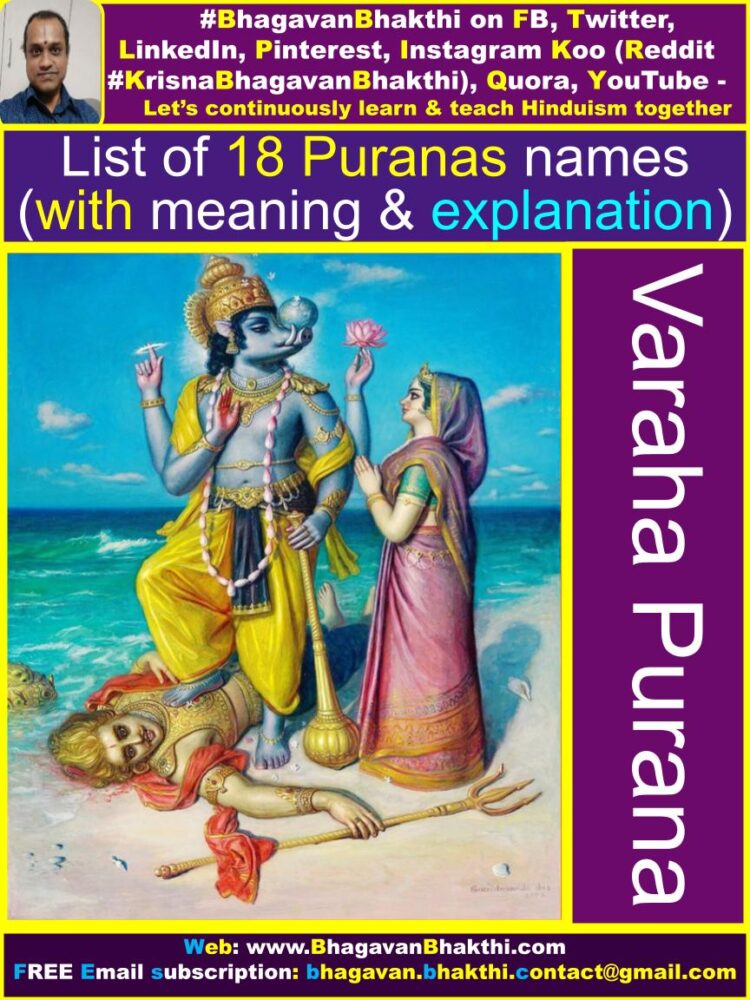
13. Skanda Purana : This Skanda Purana in Sanskrit is written as स्कन्द पुराण or स्कान्द पुराण (skanda purāṇa or skānda purāṇa). This Purana gives information about Lord Skanda or Kartikeya. It has eighty-one thousand shlokas and one desirous of punya donates the text in the month of Chaitra.
This Purana given information in different Khandas like Kedāra Khaṇḍa, Kaumārikā Khaṇḍa or Kumārikā Khaṇḍa, Arunācala Khaṇḍa or Arunācala Māhātmya.
Similarly, Skanda Purana adds information about Viṣṇu Khaṇḍa or Vaiṣṇava Khaṇḍa like Veṅkaṭācala Māhātmya, Puruṣottamakṣetra Māhātmya, Badarikāśrama Māhātmya,
Kārttikamāsa Māhātmya, Mārgaśirṣamāsa Māhātmya, Bhāgavata Māhātmya, Vaiśākhamāsa Māhātmya, Ayodhyā Māhātmya, Vāsudeva Māhātmya, etc.

14. Vamana Purana : In Sanskrit Vamana Purana is known as वामन पुराण (vāmana purāṇa). Lord Sri Brahma Deva was the first person to recite this. It has ten thousand shlokas and the text should be donated in early autumn (sharad ritu).
This text is named after Lord Sri Vishnu’s avatar Lord Vamana (Dwarf incarnation). In this Vamana Purana, Devarishi (Sage) Narada asks Maharishi Pulastya about the assumption of the Vamana avatar by Lord Sri Vishnu
The Purana has the chapters glorifying Lord Sri Vishnu and also contains chapters about Lord Shiva as well and similarly chapters about Goddesses.
The Vamana Purana has information about ‘Saromahatmya‘, that is, about the tirthas (rivers) and forests of the region around Thanesar and Kurukshetra and similarly mentions geography and sites in South India.
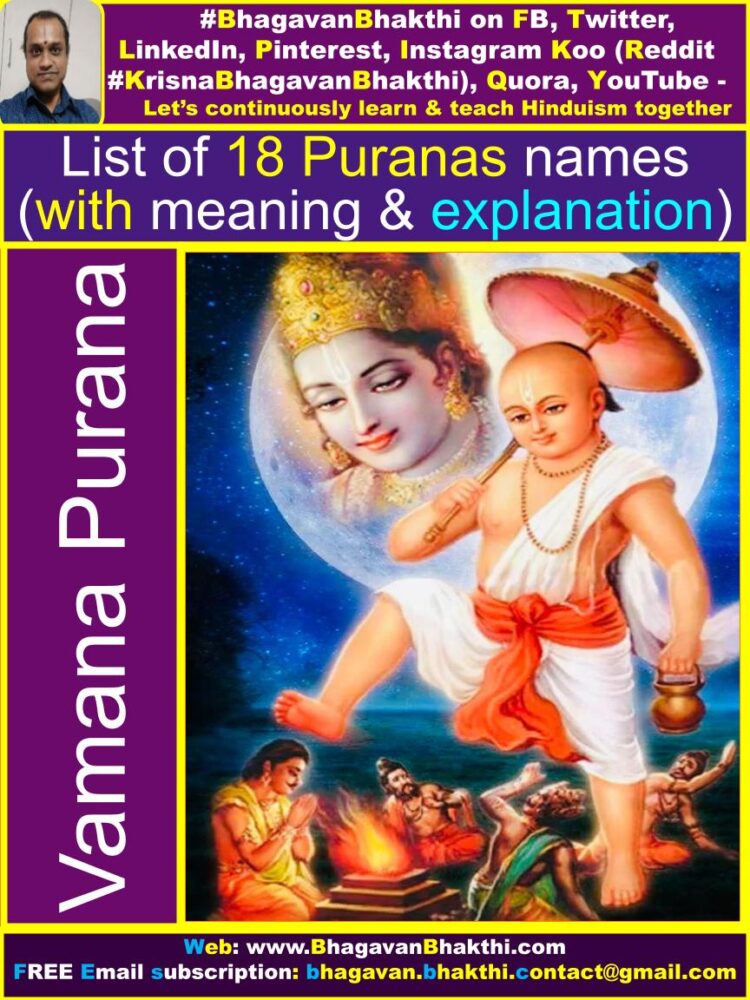
15. Kurma Purana : The Sanskrit pronunciation of this text of Kurma Purana is written as कूर्म पुराण (kūrma purāṇa). Lord Sri Vishnu recited this in his form of the avatar of Lord Sri Kurma (Turtle incarnation).
Kumar Purana has eighteen thousand shlokas and should be donated at the time of the equinoxes (Sankramana / Sankranti time).
The Kurma Purana, has the information about the philosophical Gita. This is named as ‘Ishvara-Gita‘, that is, this is spoken by Lord Shiva. This Purana presents Yoga and vrata information, with a dialogue from Lord Shiva.
The dialogue begins after Lord Sri Vishnu and Lord Shiva give a hug to each other, and then Lord Sri Vishnu invites Lord Shiva to describe about the nature of the world, life and self.

16. Matsya Purana : In Sanskrit Matsya Purana is written as मत्स्य पुराण (matsya purāṇa). Lord Sri Vishnu recited this in his form of Lord Sri Matsya Avatar (fish incarnation) to Manu.
Matsya Purana has fourteen thousand shlokas and should be donated at the time of the equinoxes (Sankramana / Sankranti time).
The Matsya Purana explains about the great flood. During this great flood whole earth and humans led by King Manu, the seeds of all plants, other living beings, as well as its knowledge books (Vedas) were saved by the Lord Sri Matsya.
This text contains information about the various topics. The text incorporates a similar coverage on legends of Lord Shiva and Lord Sri Vishnu, and also has a section on Goddess Shakti.
Matsya Purana explains about the importance of Hindu festivals and family celebrations such as those related to the Samskara (Sanskar) (rite of passage).
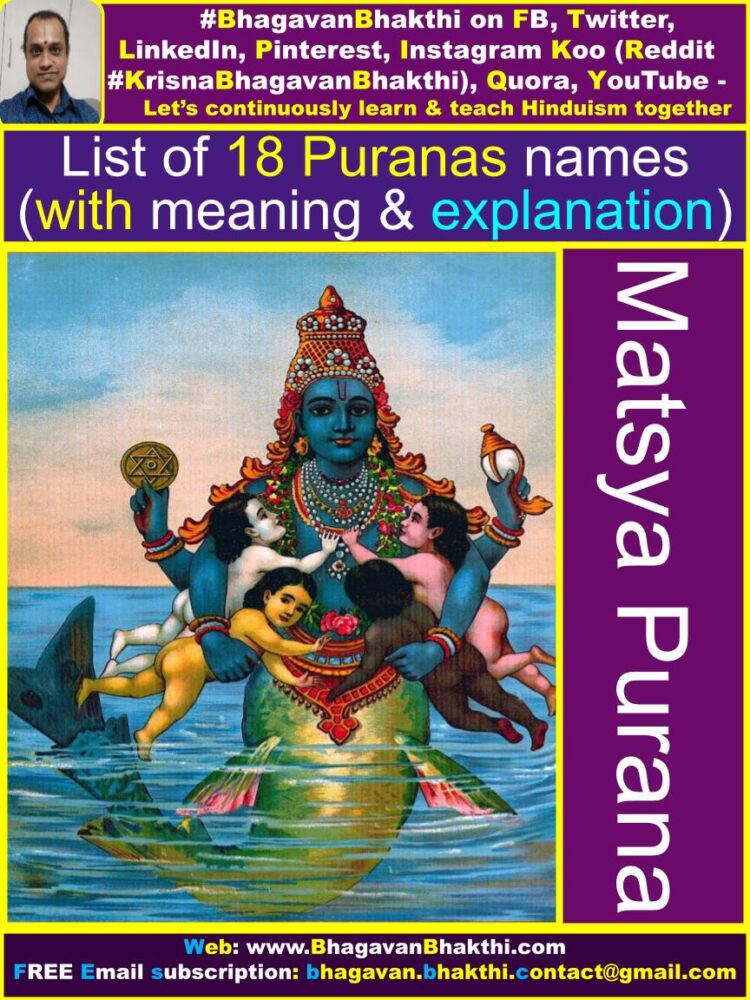
17. Garuda Purana : This Garuda Purana in Sanskrit is written as गरुड पुराण (garuḍa purāṇa). Lord Sri Krishna (Vishnu) was the first person to recite this and it has eighteen thousand shlokas. (When this text has to be donated is not stated.)
Garuda Purana chapters deals with a highly varied collection of topics. The Purana has information about Dharma, cosmology, relationship between Devatas (Demigods), ethics, good against evil, Yoga, the theory of “heaven and hell” with “karma and rebirth“, etc.
Similarly, Garuda Purana widely explains about the information about ancestral rites and moksha, rivers and geography, minerals and stones, testing methods for gems for their quality, listing of plants and herbs, etc.
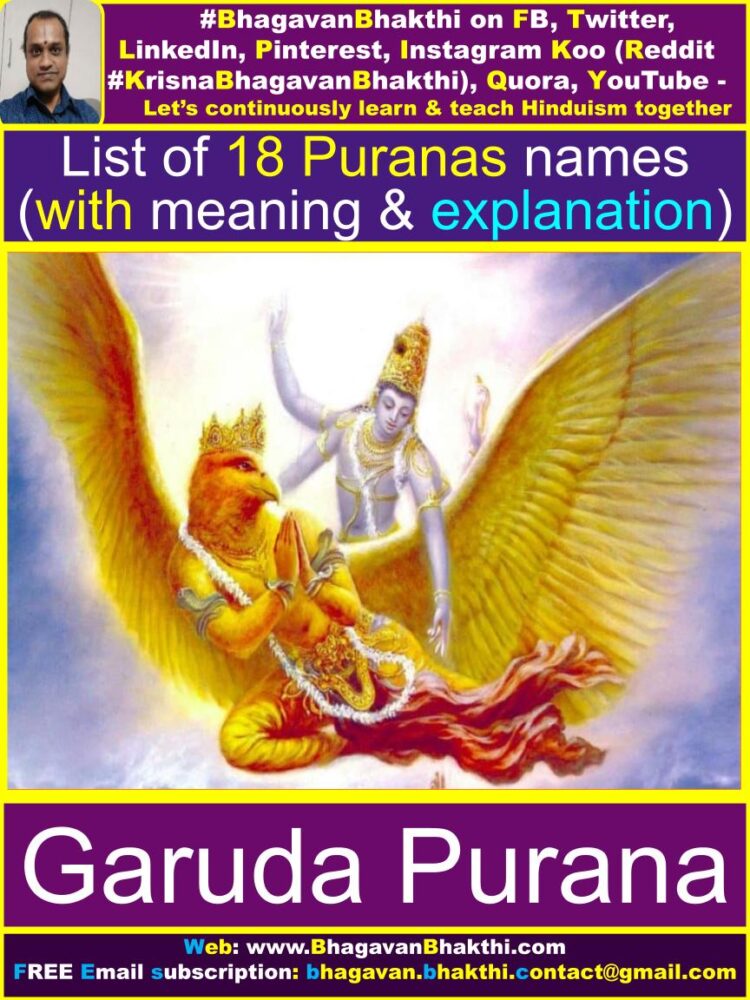
18. Brahmanda Purana : The Brahmanda Purana in Sanskrit is written as ब्रह्माण्ड पुराण (brahmāṇḍa purāṇa). Lord Sri Brahma Deva recited this first and it has twelve thousand and two hundred shlokas in it.
Comprehensive explanation about the creation of cosmos, discussion about the time as a dimension and details of Kalpa and Yuga is given in this Purana. This Purana includes information about ‘Lalitopakhyana‘, that is, the information about Goddess theology and her central importance.
Brahmanda Purana contains the details about geography related Mahatmyas (Greatness) about pilgrimage sites, rivers, temples, etc.

My dear friends please note that, these Puranas are merely for human consumption. Much longer versions are read by the Devatas (Demigods) in the higher planets. The total number of shlokas in the Puranas that the Devatas (Demigods) read is one hundred crores.
Continue reading more information about Hindu Puranas from here : Information and significance of Hindu Puranas.
More information will be added to this on regular, please visit after some time to know more information.
To watch videos on #Hinduism #Sanskrit language, SUBSCRIBE to my YouTube channel from this below link:
#BhagavanBhakthi YouTube channel
To know about “Ekadashi unknown facts” and real significances of Ekadashi fasting, kindly click the below link:
To know more about “Lord Krishna unknown facts“, please click the below link:
To know more about “Lord Vishnu unknown facts“, please click the below link:
To know more about “Lord Shiva unknown facts“, please click the below link:
Dear friends, if you need any clarifications about this post, kindly let me know, I will definitely try to answer all of them.
Also your one LIKE, one COMMENT, One Share, one SUBSCRIPTION is highly important.
This will help to know the quality of this content and also it will be helpful to know if any improvements is required for the content.
If you feel this content is useful to you and has helped you to improve your knowledge, kindly share this with your well-wishers.
Because “SHARING MEANS CARING”.
For receive FREE EMAIL SUBSCRIPTION about #BhagavanBhakthi, you can send an email to [email protected] from your email ID.
NAMASTE!
Sri Gurubhyo Namaha
OM NAMO NARAYANAYA
Sri Krishnaarpanamastu
Subscribe / Follow us Share in Social Media
I truly enjoy looking at on this web site, it contains wonderful content.